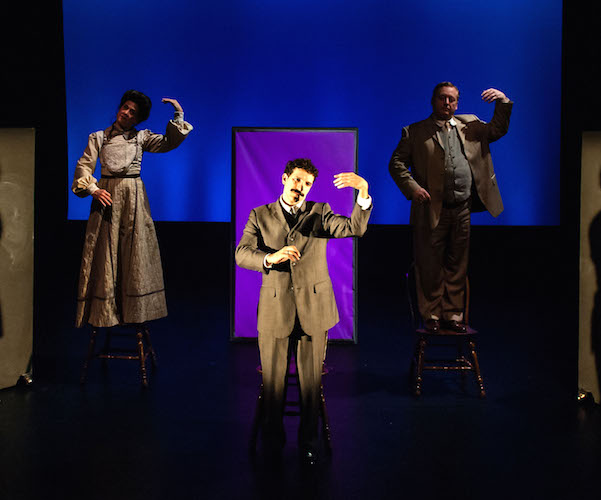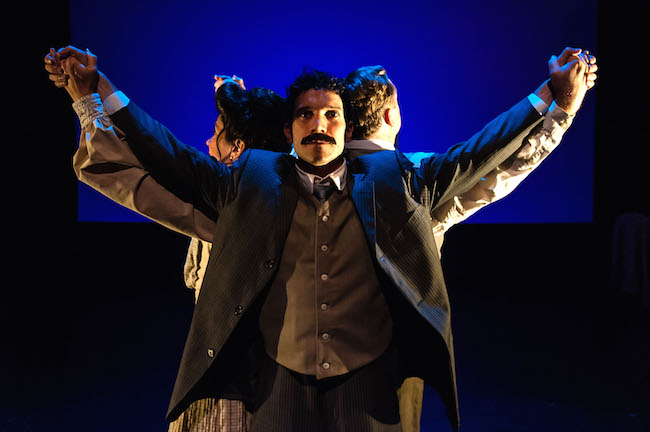Theater Review: “Einstein’s Dreams” — Time After Time
Wesley Savick not only does a fine job of adapting Alan Lightman’s text, but in his role as director he squares the circle: his stage version runs like clockwork yet breathes like an organic whole.
Einstein’s Dreams, adapted by Wesley Savick from the novel by Alan Lightman. Directed by Wesley Savick. Presented by Underground Railway Theater at Central Square Theater, Cambridge, MA, through November 14.

Debra Wise, Robert Najarian, and Steven Barkhimer in the Underground Railway Theater production of “Einstein’s Dreams.” Photo: A.R. Sinclair Photography.
By Ian Thal
The programing of Underground Railway Theater, one of the two resident companies at Central Square Theater is defined by artistic director Debra Wise’s highly eclectic interests — one of which has been her dedication to portraying the history of science on stage in her role as co-director of the Catalyst Collaborative@MIT. Among the fruits of that ongoing collaboration was Wesley Savick’s 2007 stage adaptation of MIT professor Alan Lightman’s 1992 novel Einstein’s Dreams, which is currently being revived with its original cast and most of the initial staging’s design team. While the Savick’s is neither the only nor the first such stage adaptation — David Gardiner and Ralf Remshardt premiered a popular one in 1996 that calls for a larger cast — it will delight fans of the original book.
The novel presents itself as Albert Einstein’s dream journal from April through June of 1905, when, while working as a clerk in the Swiss Patent Office in Bern, he developed his Special Theory of Relativity. In an attempt to reconcile the classical mechanics of Isaac Newton with James Clark Maxwell’s work on electromagnetism, Einstein was forced to reconceive everything physicists had previously taken for granted about the relationship between space and time. His suggestion that neither space nor time could be explained in terms of either Euclidian or Cartesian geometry would quickly move from a controversial hypothesis to an experimentally verified theory. Einstein’s name became a byword for genius.
Many of the dreams are vignettes about how the people of Bern would live their lives if they acutely experienced the effects predicted by the Relativity Theory: time-dilation, localized frames of reference, and the curvature of spacetime by gravity. Other dreams are more metaphysical. What if cause and effect were not so intimately entwined? What if entropy was reversed and things became more ordered over time? Other reveries toy with even more fantastical notions, such as if we all had infinite time to live, or had no long-term memory, or no sense of the future, or remembered our future and anticipated our pasts.
Savick’s relatively free adaptation, though it must necessarily abridge the text (and scramble up its structure) in order to fit the requirements of a seventy-minute one-act play, captures Lightman’s nimble tone, often by freely quoting long passages from the book. While the interludes regarding Einstein’s waking life are largely kept intact, the individual dreams in the novel are run together into a series of dreamscapes, recalling the fantasy in which time becomes like space — so we could simply run to any time we like (or, if time were like a book, we could simply dog-ear our favorite moments).
Savick not only does a fine job of adapting Lightman’s text, but in his role as director he squares the circle: his stage version runs like clockwork yet breathes like an organic whole. Of course, the evening is a meditation on the differences between the mechanical and the natural.
Robert Najarian as Einstein, Steven Barkhimer as Michele Besso, Einstein’s friend and colleague at the Patent Office, and Debra Wise as the typist slide comfortably back into the roles they originated in the 2007 production. The level of communicative ease that comes with familiarity supplies the technical precision necessary for a play about time. Each performer has his or her special strengths: Najarian is the most acrobatic and vigorous dancer of the three, Barkhimer’s existential clowning inevitably brings out the absurdity in the subtext, and Wise can be counted on for delicate pantomime. Yet the interlocked strengths of their shared physical vocabulary means that they play together as if they were a veteran chamber ensemble.

Debra Wise, Robert Najarian, and Steven Barkhimer in the Underground Railway Theater production of “Einstein’s Dreams.” Photo: A.R. Sinclair Photography.
The fourth member of the ensemble is accordionist and percussionist Roberto Cassan, here building on the work of his friend and colleague, Evan Harlan, the composer and musician for the original 2007 production who last year died of brain cancer. Cassan’s accordion evokes the Swiss setting where the musical cultures of Francophone, Italian, and Germanic Europe meet, while his percussion work, when the nature of time is being explored, playfully shifts tempos, alternating between restraint and rubato.
Leslie Held’s costumes evoke the formal work attire of the early twentieth century while also leaving the cast unconstrained in their movements — a particular triumph: the almost floor-length skirt, elaborate blouse, and gigantic Gibson-Girl style wig worn by Wise.
In direct contrast to the picturesque Alpine setting in Lightman’s book — the River Aare as well as the shops, cafés, and streets of Bern — Wen Ti Tsin has chosen a minimalist scenic design that proffers only three chairs and three panels (on wheels). That approach keeps the audience’s focus on the ideas contained in the text and the movements of the actor’s bodies. Steven McIntosh’s lighting and projection design is similarly minimalistic, only calling attention to itself when it brings in elaborate effects to heighten the dramatic. Visual highlights include when he uses shadows to illustrate multiple frames of reference (creating multiple shadows of Najarian miming playing the violin), and when he finally projects a more realistic representative of Bern through the patent office window, an image that provides a very clever twist on the novel’s epilogue.
The play is by no means a documentary about Relativity Theory, nor are these dreams copies of Einstein’s formal thought experiments. Rather, the stage is used here as a means to explore the interactions of desire and identity in time. Many of us have experienced moments we wished we could freeze in eternity: what if we could? How would we love if we knew our future was pre-determined from the beginning of time? What if we needed to consult a journal to remember who we were yesterday? What if, for every decision we made, we knew there were alter-egos who decided differently, each with their own alter-egos making their own decisions? How would that change the way we see the world? Time to cite Jorge Luis Borges, a writer obsessed with time and an admirer of the Greek philosopher Heraclitus, in his poem “The Art of Poetry”: “To gaze at a river made of time and water/ and remember Time is another river./ To know we stray like a river/ and our faces vanish like water.”
Ian Thal is a playwright, performer and theater educator specializing in mime, commedia dell’arte, and puppetry, and has been known to act on Boston area stages from time to time, sometimes with Teatro delle Maschere. He has performed his one-man show, Arlecchino Am Ravenous, in numerous venues in Massachusetts and Rhode Island. One of his as-of-yet unproduced full-length plays was picketed by a Hamas supporter during a staged reading. He is looking for a home for his latest play, The Conversos of Venice, which is a thematic deconstruction of Shakespeare’s The Merchant of Venice. Formerly the community editor at The Jewish Advocate, he blogs irregularly at the unimaginatively entitled From The Journals of Ian Thal, and writes the “Nothing But Trouble” column for The Clyde Fitch Report.
Tagged: Alan Lightman, Central Square Theater, Einstein's Dreams, Relativity, Underground Railway Theater
